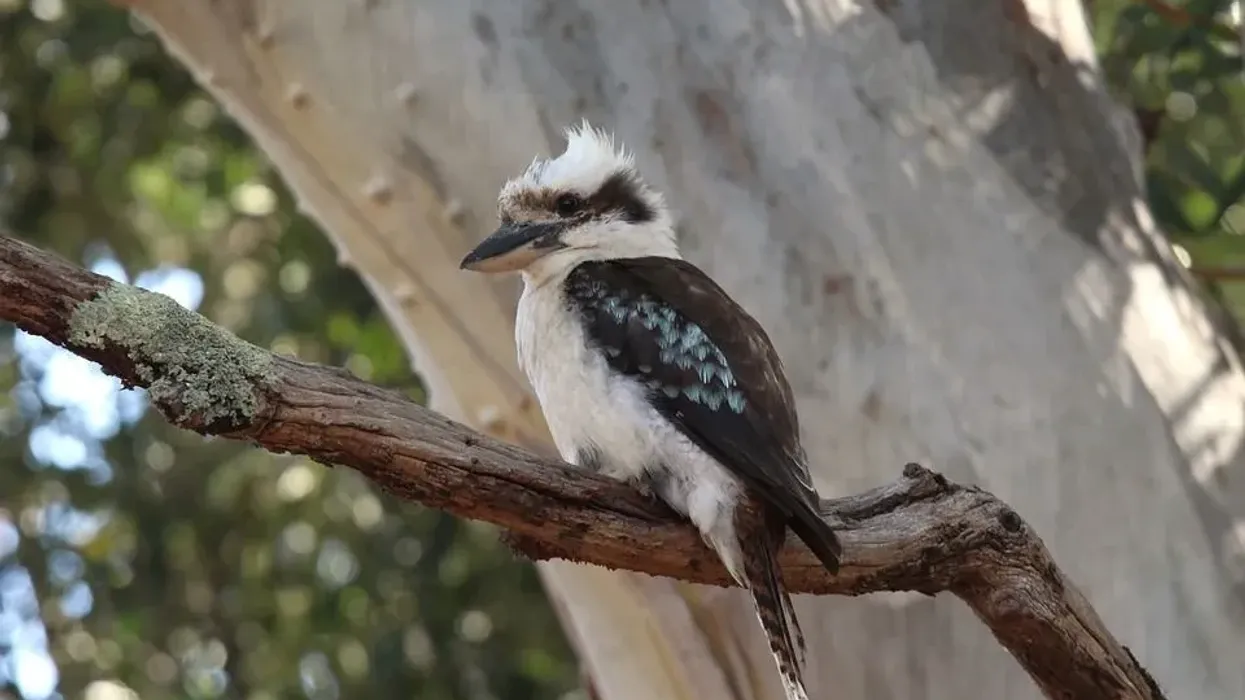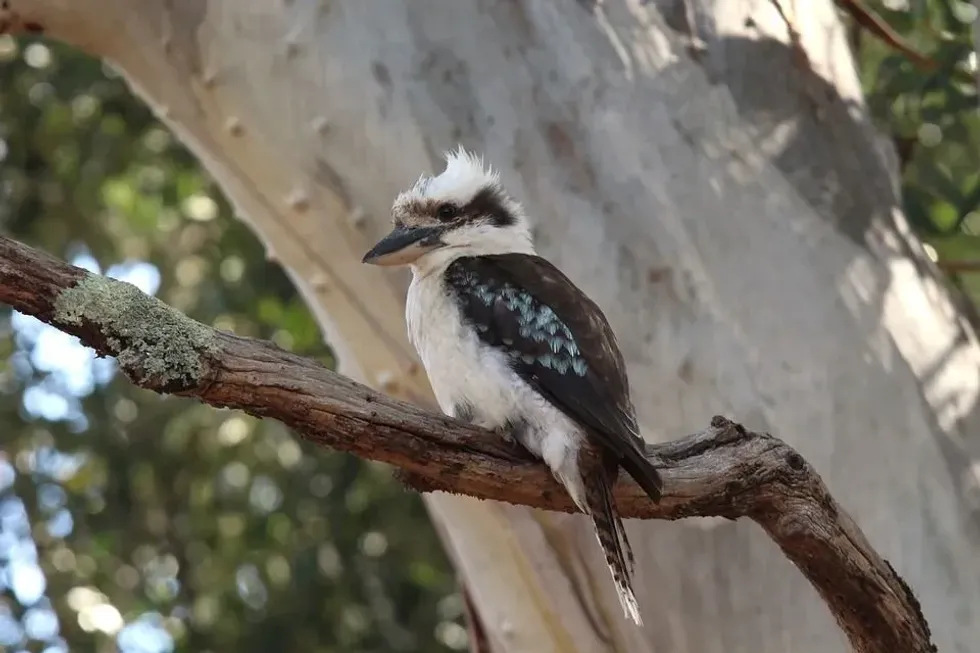A laughing kookaburra, referred to as laughing jackass or giant kingfisher is a laughing bird native to eastern Australia. Kookaburra is important because it is the largest member of the kingfisher family.
Their habitats constitute woodland, forest areas, parks, and gardens. These birds make a distinctive sharp call through a complex sound-producing mechanism, that resembles raucous laughter hence they are called laughing kookaburra.
These sounds are produced to mark their territory, protect or attract mates and maintain the social hierarchy. They have dark brown eyes, a large head, and a long pointed beak.
They can be distinguished from their counterparts the blue-winged kookaburra by their distinct laughter. They can also be separated from blue-winged kookaburra by their dark eye, shorter size of the bill, and duller blue spots.
These birds are monogamous and sedentary in nature, they occupy the same territory throughout the year. Their breeding season usually begins from September-November continuing till the summer seasons in some cases.
The females usually lay eggs in holes of trees tree or in excavated holes within the nests of termites. The older siblings assist the parents to nurture the eggs, nurture the kookaburra chicks and collect food.
These birds are carnivorous in nature, preys on mice, lizards, small snakes, insects, or other small animals.
They catch their prey by waiting for prey to pass by and then pounce on them. In the IUCN red list, they are declared as species of least concern because of no widespread threats and stable population.
Laughing Kookaburra Interesting Facts
What type of animal is a laughing kookaburra?
Laughing kookaburra Dacelo novaeguineae, also known as the laughing jackass, is a carnivorous bird belonging to the kingfisher family.
What class of animal does a laughing kookaburra belong to?
Laughing kookaburras belong to the class Aves. Their scientific name is Dacelo novaeguineae.
How many laughing kookaburras are there in the world?
The total population of laughing kookaburras in the world is approximately 65 million.
Where does a laughing kookaburra live?
Laughing kookaburras are originally from eastern Australia. They can be seen from the Cape York Peninsula in the north to Cape Otway in the south.
They are found on the Great Dividing Range. They have also been found in Tasmania, Western Australia, Kangaroo Island, Flinders Island, and New Zealand. The range of the laughing kookaburra merges with the blue winged kookaburra near eastern Queensland that extends from the Cape York Peninsula in the south to Brisbane.
What is a laughing kookaburra's habitat?
Laughing kookaburras can be seen mostly in Eucalyptus and sclerophyll forests. Their habitat usually consists of woodlands and grasslands. They generally favor areas having an understory or undergrowth also known as underbrush.
These areas comprise of plants growing beneath the forest canopy without penetrating into any deeper levels but above the forest floor. Scanty amounts of sunlight can reach these places so they are shade tolerant.
They are also found in wetlands and farmland. In urban areas, they can be seen mostly in parks and gardens. They are sedentary and tend to live in the same territory throughout the year.
Who do laughing kookaburras live with?
Laughing kookaburras are usually found in loose groups. They live in close family units where the older siblings look after the next generation of offsprings along with helping the parents to hunt.
How long does a laughing kookaburra live?
The average life span of a laughing kookaburra is 15-20 years.
How do they reproduce?
They are monogamous in nature having the same partner throughout their life. The breeding pair vocalizes their mating call. They nest in tree holes.
Nest building usually starts in August. Their breeding season starts in September-November which might continue to the summer months. Female kookaburras lay one to five eggs.
Their family groups consist of both the parents along with elder siblings who nurtures the offsprings. The breeding pair along with the helpers incubate the eggs and feed the chicks. The chicks are continued to be fed until they are independent.
What is their conservation status?
According to the International Union for Conservation of Nature (IUCN) red list, they are declared as species of least concern owing to their current stable population and no widespread threats. They are not considered threatened but the growing loss of their habitat is a primary concern.
Laughing Kookaburra Fun Facts
What do laughing kookaburras look like?

Laughing kookaburra is the largest member of the kingfisher family. It has got distinct dark eyes with brown eye stripes that run across its face and a large bill. They have a large white head with creamy white underparts. Their beaks are long which helps them to catch a variety of prey.
It also has light blue spots on its brown wings. The white, brown, and black colors in its plumage make it easier for them to camouflage against their surroundings. The tail is reddish-orange in color.
How cute are they?
Their cuteness usually stems from their appearance. They have different colors all over their body with prominent brown eyes and blue spots on the shoulders. Their laughter is also unique and sets them apart from other birds.
How do they communicate?
They make a very distinctive call to mark their territory that sounds like raucous laughter and hence the name 'Laughing kookaburra' or 'Laughing jackass'. Their call is produced through a complex kookaburra sound-producing mechanism by forcing air from lungs to bronchial tubes.
Their territorial kookaburra song is delivered by many birds at the same time in a chorus. These calls are made either to protect or attract mates, to guard their territory against rival tribes, or to maintain social hierarchy in the family groups.
How big is a laughing kookaburra?
They happen to be the largest member of the Kingfisher family. These birds can grow up to 16-19 in (41-47 cm) in length. Its beak is four inches long. Almost nine times the size of a bee hummingbird (5 cm or 1.96 in).
How high can a laughing kookaburra fly?
They usually prey from a perch which is at a height of 3.3 -6.6 ft (1-2 m) above water. They are slow-flying birds. They fly down to catch it's prey from the ground or inside water bodies, not deeper than 25cm (9.8 inches) below sea level.
How much does a laughing kookaburra weigh?
The male kookaburra weighs 0.432-0.992 lb and the female weighs 0.418-1.025 lb.
What are their male and female names of the species?
There are no distinct names of the male and female species. Scientists usually refer to them as laughing kookaburra.
What would you call a baby laughing kookaburra?
The baby laughing kookaburra is usually referred to as a chick.
What do they eat?
They usually prey on insects, lizards, worms, snakes, small birds, mice, or other small animals. They also have goldfish from the garden pond. They don't need to drink as they get water from their food.
Are they loud?
They start calling in chorus. They have a tracheobronchial syrinx which can produce two frequencies of vibrations which gives rise to multiple harmonics. Thus a high-pitched sound is produced that resembles raucous laughter.
Would they make a good pet?
It is not recommended to keep these birds as pets. The reasons being they are extremely temperamental, need a lot of space, and tend to stay in groups.
The NSW Native Animal Keepers' Species List has declared the requirement of a permit to keep Laughing kookaburra as a pet. Also, it has been mentioned that they cannot be kept as companion pets.
Did you know...
Laughing kookaburras are also known as smiling birds because of their unique call which sounds like raucous laughter. It is a learned behavior taught to the fledgling by the parent birds. They are also known as the 'bushman's clock' as they are heard early in the morning and right after sunset, in dawn and dusk.
They are also a part of a famous Australian children's song the 'Kookaburra' by Marion Sinclair in 1934. So they are an integral part of Australian culture.
What film was the laughing Kookaburra in?
In the famous Hollywood movie 'Tarzan Of The Apes' in 1918 the calls of the laughing kookaburra are featured in the jungle scenes in Africa despite the bird not belonging to that area.
What is a laughing Kookaburra's social structure like?
They are usually semi-monogamous and live in loose family groups. Their family consists of both the parents and their offsprings. The offsprings generally act as helpers, assist the parents to hunt for food, and incubate the eggs. The chicks are fed until they are able to do so by themselves.
Here at Kidadl, we have carefully created lots of interesting family-friendly animal facts for everyone to discover! You can even occupy yourself at home by drawing one on our Laughing kookaburra coloring pages.








